
Rock Hill Utilities is committed to being “Always on.” City staff will continue their endeavor to provide safe, reliable drinking water that exceeds US EPA and SCDHEC drinking water regulatory standards.
"Water is the driving force of a nature."
- Leonardo da Vinci
FROM THE DIRECTOR
On behalf of the City of Rock Hill Utilities Department, I am pleased to present the 2019 Water Quality Consumer Confidence Report (CCR). This report contains fundamental information about where your water comes from, what it contains, and why that is important.
Rock Hill Utilities values the trust you put in its staff every day to safeguard the quality and reliability of your drinking water. As part of the safeguard process, Rock Hill Utilities’ staff monitors the water treatment processes 24 hours a day, 365 days a year. State certified operators utilize a central monitoring system to observe water treatment functions, including storage tank levels, system pressures, and flows. Staff and automated monitoring equipment also perform tests throughout the process to ensure that quality drinking water is being distributed to our customers.
Over the past year, the City has continued its work to ensure that its customers have quality water at ample supply and pressure at their taps. Currently the Water Filter Plant (WFP) on Cherry Road has a peak demand of 29 million gallons per day (MGD) with a peak hourly demand of 32.0 MGD. That peak demand continues to rise with growth in the eastern part of York County. In order to meet projected demands, construction to expand the plant’s treatment capacity from 36- to 48-MGD began in February 2018 and the new filters should be in operation by the time you receive this report.
The City recently installed several large-diameter water lines that radiate out from the water filter plant. These water lines provide intercity interconnects and the necessary infrastructure to support the customer demands and growth around the Rock Hill community. All but one are completed; the remaining one planned for Mt. Gallant Road between Anderson Road and Dave Lyle Boulevard. We are reviewing our storage volume on the distribution system and have plans to add a new elevated water storage tank over the next couple of years.
Water quality is a growing topic, and the City makes great efforts to ensure quality drinking water is provided to its customers. Our system has won awards for exceeding state and national drinking water standards. We tested our source water at the intake on Lake Wylie on several occasions and found the PFAS (per/poly fluoroalkyl substances) concentrations at very low levels – well below the EPA action level of 70 parts per trillion (ppt). We are collaborating with area schools and utilities in the Catawba River Basin to discuss critical issues. We have recently completed our Risk and Resilience Assessment of the water system and now are working to update our emergency response plans.
The City of Rock Hill strives to provide its citizens and customers with an uninterrupted supply of safe drinking water. You and your family can feel secure in knowing that the City of Rock Hill provides drinking water that continues to exceed Federal and State regulatory standards. Thank you for your business and trust.
Mark Kettlewell, PE, PLS Director of Water & Sewer Utilities

MESSAGE
A
WATER SYSTEM CONSTRUCTION
Flocculation/Sedimentation Basins
A coagulant is added to the source water which causes the impurities to stick together to form a "floc." The heavy floc settle to the bottom of the basins and is removed and sent to the clarifier.
As water demands increase, an additional 500,000 gallon clarifier will receive sludge from the sedimentation basins and sediment-laden filter backwash water.


Filterbed Piping & Monitoring
Housed in the new building first floor, the piping and monitoring stations record the reading of water turbidity as it leaves the filters. The SCADA control station (below) monitors filter performance.
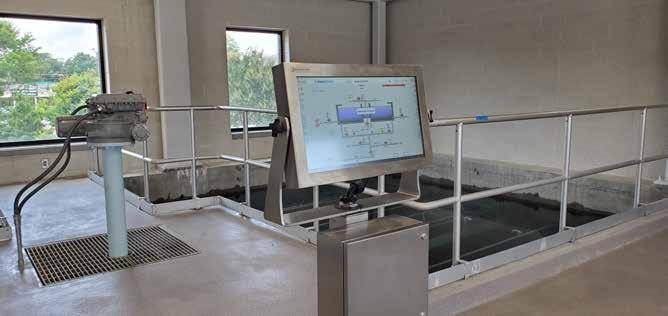
New Filter Building
The new multi-level filtration building houses state-of-the-art filtering beds with multiblock filter bottoms which enhances particle removal. The filtration process comes after flocculation and sedimentation. The water then goes to the large round clearwells.
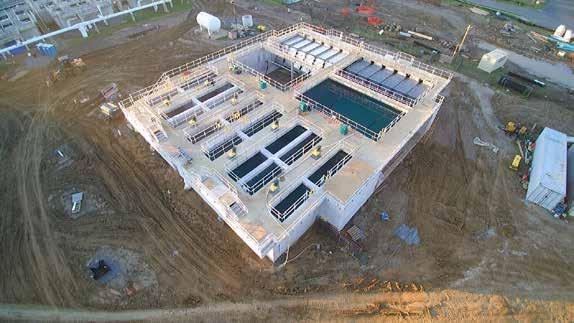
 New Clarifier
New Clarifier
WATER SYSTEM UPGRADES
make water more available in the outer reaches of the City’s system, and upgrades at the water filter plant on Cherry Road are underway to increase the treatment capacity and boost the efficiency of the plant. In addition to the ability to produce more water at the plant, some of the other improvements include
• Improved security features at the raw water intake and the water filter plant.
• A technologically-advanced supervisory control and data acquisition (SCADA) system for monitoring the treatment processes from Lake Wylie to the distribution system and for adjusting pumps and valves remotely.

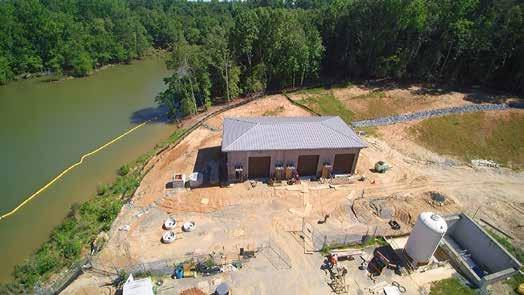
Lake Wylie.
• A new training room at the water plant where all water plant staff can meet together.
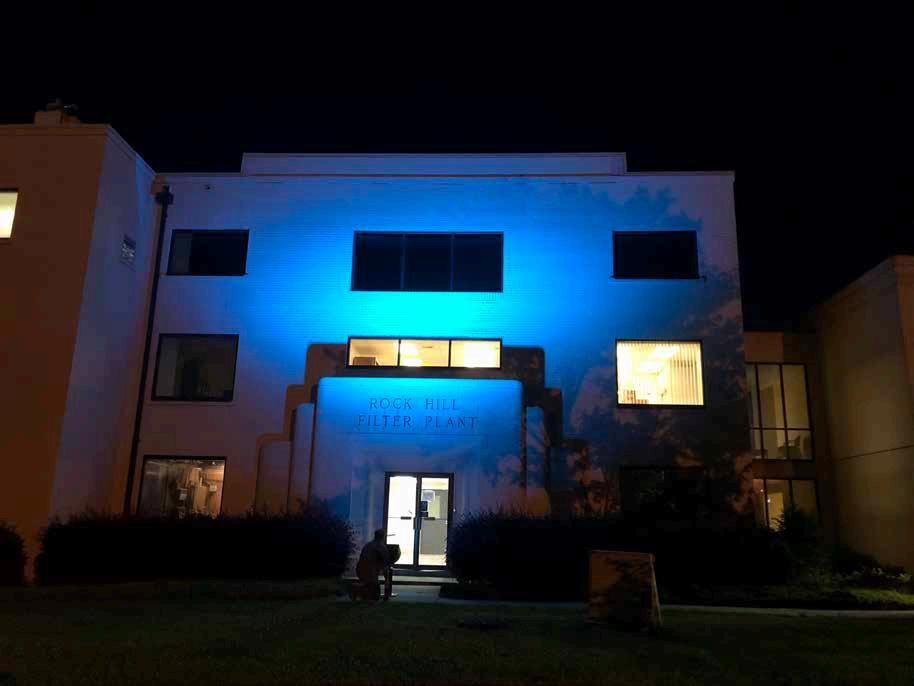
• Accommodations for staff who need to remain at work for extended periods due to inclement weather or other emergencies.
These improvements, along with the construction for increased capacity, will help us to provide continuous service to you and your business. Our operators, crews, lab technicians and maintenance personnel are Always On to provide around-the-clock supply of drinking water to our customers.
Lake Wylie Raw Water Intake Secure Site and New Chemical Building
Important Information About Your Water
WHY YOU SHOULD READ THIS REPORT
To ensure that tap water is safe to drink, the EPA prescribes stringent maximum contaminant levels (MCLs) for certain contaminants in water supplied by public water systems.
All sources of drinking water are subject to potential contamination by substances that are naturally occurring or man made. All drinking water, including bottled water*, may reasonably be expected to contain at least small amounts of some contaminants. The presence of contaminants in drinking water does not necessarily indicate the water poses a health risk. More information about contaminants and potential health effects can be obtained by calling the Environmental Protection Agency’s Safe Drinking Water Hotline at 1-800-426-4791. You can also visit the EPA’s website at https://www.epa.gov/ground-water-and-drinking-water
DRINKING WATER CONTAMINANTS
The sources of both drink ing water and tap water include rivers, lakes, streams, ponds, reser voirs, springs and wells As water travels over land sur faces and underground, it dissolves naturally occurring minerals and radioac tive minerals, and it can pick up substances resulting from the presence of animals and human ac tivity.
CONTAMINANTS THAT MAY BE PRESENT IN SOURCE WATER INCLUDE:
• M icrobial contaminants, such as viruses and bac teria, which may come from wastewater treatment plants, septic systems, agricultural livestock operations and wildlife
• Inorganic contaminants, such as salts and metals, which can be naturally-occuring or result from urban storm water runoff, farming, mining, industrial or domestic wastewater discharges, or oil and gas production.
• Pesticides and herbicides, which may come from a variety of sources such as agriculture, urban storm water runoff or residential uses.
• Organic chemicals, including synthetic and volatile organic chemicals, which are by-products of industrial processes and petroleum production, and can also come from gas stations, urban storm water runoff, and septic systems.
• Radioactive contaminants, which can be naturallyoccuring or be the result of oil and gas production and mining activities.
CONTAMINANT INFORMATION
Removing all contaminants from drink ing water would be ex tremely costly, and in nearly all cases, this would not provide any greater protec tion to health. In fac t, a few naturally-occurring substances may ac tually improve the taste of drink ing water and may have low-level nutritional values.
For most customers, water that meets all federal, state and local regulations is considered safe to drink Some customers may be more vulnerable to contaminants in drink ing water than the general population. People with cancer undergoing chemotherapy, persons who have undergone organ transplants, people with HIV/AIDS and other immune system disorders, and some elderly people and infants can be at par ticular risk from infec tion. People with these health concerns should seek advice about drink ing water from their healthcare provider EPA/CDC guidelines on appropriate means to lessen the risk of infec tion by cr yptosporidium and other microbial contaminants are available by calling the EPA SAFE DRINKING WATER HOTLINE at 1-800-426-4791.
*FDA regulations establish limits for contaminants in bottled water which must provide the same protec tion for public health.
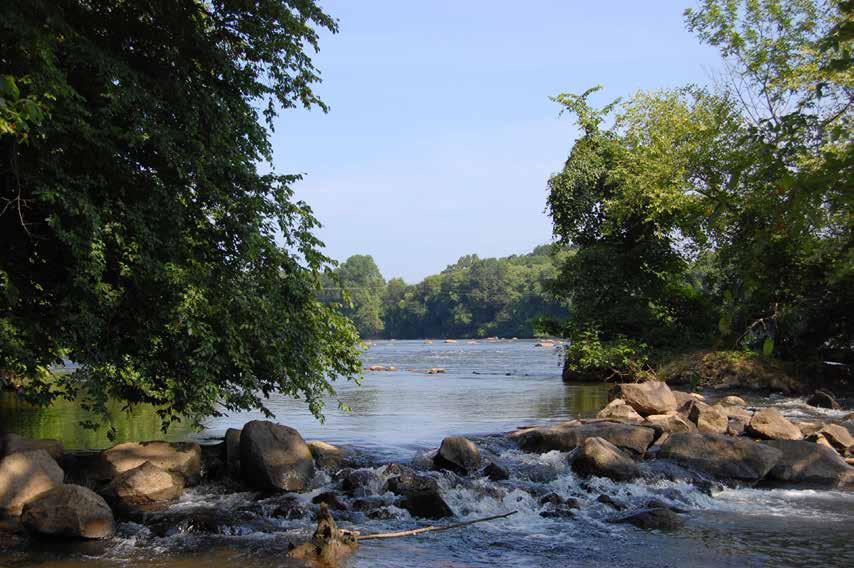
YOUR DRINKING WATER SOURCE
The City of Rock Hill water system is located in York County, South Carolina, in the Catawba River Basin. Rock Hill Utilities treats and distributes water to a primary population of over 73,068 retail customers in Rock Hill. In addition, water is distributed through wholesale customers in York County including Fort Mill, Tega Cay, City of York, River Hills, the Catawba Indian Nation and a small number of private water suppliers in the area. Rock Hill Utilities is well prepared to continue being the area’s regional water provider for years to come.
The drinking water sources for the system are surface water intakes in the Catawba River/Lake Wylie. Water is then pumped to the treatment plant on Cherry Road. There, conventional treatment and chemical addition produce the water you consume. Access to our raw water intake and treatment plant is highly restricted and closely monitored around the clock.
The South Carolina Department of Health and Environmental Control (SCDHEC) serves as coordinating agency for the State’s Source Water Assessment and Protection Program (SWAP), a program required by EPA’s 1996 amendments to the Safe Drinking Water Act. SWAP provides added protection of the City’s water by conducting assessments for all drinking water sources across South Carolina and implementing safeguard measures.
In 2012, the South Carolina Department of Health and Environmental Control completed the Watershed Water Quality Assessment for the Catawba Basin. The assess-
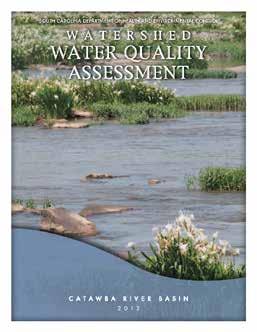
ment provides an inventory of potential contaminant sourc es (PCSs), identifies poten tial contaminants of inter est, and ranks the potential susceptibility of these PCSs with respect to the water source. SCDHEC has identified Rock Hill’s source water to be susceptible to contam inants such as volatile organic contaminants, petroleum products, metals, nitrates, pesticides, and herbicides. The City of Rock Hill continually monitors for the presence of these contaminants, and through state-of-the-art filtering and disinfecting techniques, delivers safe drinking water to its customers. For a complete copy of this assessment report, contact Susan Featherstone at 803-329-5502 or visit South Carolina Department of Health and Environmental Control: https://scdhec.gov/sites/default/files/docs/HomeAndEn vironment/Docs/Watershed/wwqa/Catawba_WWQA_20 12.pdf
ROCK HILL UTILITIES WATER TREATMENT AND DISTRIBUTION SYSTEM

Miles of Water Main Lines: 521 Miles
Inline Valves: 6,868
Fire Hydrants Maintained: 3,106 Hydrants
Number of Elevated Water Tanks: 5 Elevated Tanks totalling 4.75 million gallons in storage
Number of Water Meters: 33,082 Meters
Average Daily Consumption: 20.3 Million Gallons
Annual Finished Water: 7.4 Billion Gallons
Maximum Plant Capacity: 36 Million Gallons Per Day
Population Served: 130,000 (Rock Hill, York County, Fort Mill, Tega Cay and Catawba Indian Nation)
Water Treatment Pro
Water Source Absorption
Primar y Disinfection, Oxidation, Chlorine Dioxide
Lake Wylie/Catawba River Intake
Clear wells
Elevated Water Storage Tanks
Powdered Activated Carbon (taste & smell control)
Post-Rapid Mix
Lime, Phosphate, Chlorine, Fluoride
Filtration
Chlorine
Distribution
Finished Drinking Water
Anthracite
Sand
Homes Businesses
ocess
Pre-Rapid Mix
Before arriving at your tap, water is treated at the Rock Hill Water Treatment Plant to remove sediment, bacteria, and other impurities. The plant provides drinking water that exceeds SCDHEC and US EPA water quality regulatory standards.
Water Sources
Water from Lake Wylie and Catawba River intakes flow through large pipes to our plant.
Absorption
Powdered activated carbon (PAC) is added to adsorb natural organic matter to control taste and smell.
Pre-Rapid Mixing
Water is rapidly mixed with aluminum sulfate (alum), a coagulant that helps the impurities stick together to form bigger particles called floc. Another dose of disinfectant is added to continue the disinfection process.
Carbon control)
Disinfectant and Coagulant
Flocculation
After rapid mixing, the water flows into flocculation basins, where the velocity of water is slowed and the floc has time to grow bigger.
Filtration and Businesses
Flocculation/ Sedimentation
Chlorine acite Sand
Sedimentation
Next, the water flows into sedimentation basins, where heavy floc particles sink to the bottom and are removed.
Filtration
Now the water travels through large filters made up of layers of anthracite, sand, and gravel. These filter layers remove remaining microscopic particles and microorganisms.
Post-Rapid Mixing
Finally, the water is disinfected to protect against bacteria. Lime is added for pH adjustment and phosphate added for corrosion control. Fluoride is added to support good dental health.
Clearwells
After treatment, the water travels through a series of three clearwells allowing water to have contact time with the disinfectant before leaving the plant. This deters bacteria regrowth when water enters the distribution system.
Water Tower Storage Tanks
Elevated water tanks dampen pressure fluctuations in the distribution system and are also used as storage for emergencies such as fires.
Distribution
Treated water is then pumped into pipes that deliver it to more than 100,000 residences and businesses in Rock Hill and York County.
DRINKING WATER & COVID-19
The World Health Organization states that there is no evidence that COVID-19 can be transmitted by treated drinking water. The US Environmental Protection Agency (EPA) also states that COVID-19 has not been detected in drinking-water supplies and that Americans can continue to use and drink water from their tap as usual.
Our drinking water is a safe and affordable way to access water for drinking, cooking and maintaining personal hygiene during the COVID-19 outbreak. Cleaning your hands and commonly used surfaces is very important in controlling the spread of COVID-19.
Water infrastructure and its operators are critical to the supply of safe drinking water to our homes, businesses, and hospitals. Our operators, lab, maintenance, and administrative staff have been working 24 hours a day, 7 days a week to treat the water you depend on and to ensure an abundant supply of drinking meets or exceeds all regulatory requirements.
Water for the City of Rock Hill comes from Lake Wylie and is pumped to the City’s treatment facility on Cherry Road. The City uses a proven, conventional method to treat water for use by Rock Hill customers. The processes used in conventional treatment include sedimentation of large particles, filtration of small particles, and disinfection. The City also monitors and adjusts the pH of the water, adds fluoride to the water to reduce tooth decay and adds corrosion inhibitors to prevent metals from leaching from pipes and plumbing systems.
Regular cleaning and disinfection is shown to be effective in slowing the spread of COVID-19. For homes and businesses, this includes using soap and tap water to clean, and bleach and other similar chemicals to disinfect. Cleaning with soap and water removes germs, dirt and impurities from surfaces; disinfecting kills germs on surfaces.
Disinfection is also a part of the conventional treat ment process at the City of Rock Hill water treatment facility. Both chlorine gas and chlorine dioxide is used to disinfect the water prior to sending it to your homes through the distribution system.
All federal and state requirements for water treat ment are being implemented, even through the COVID-19 pandemic. This means it is not necessary for you to boil your water prior to using it. It also
means that tap water can be used for hand washing, drinking, cleaning, and other typical uses.
Re-opening Businesses - Maintaining and Flushing Water Lines and Equipment
Businesses and buildings closed during stay at home orders could have stagnant water inside the building’s plumbing. As water ages, the disinfectant residual levels lower causing changes in water chemistry that may affect the quality of the water. EPA recommends that building owners and managers take proactive steps to protect public health by minimizing water stagnation during closures and taking action to address building water quality prior to reopening. Here are a few steps recommended by the EPA and CDC:
• Inspect building plumbing to ensure it is functioning properly and is in good condition. Also, check for mold and other signs of leaks or condensation.
• Maintain any water treatment systems used in the building.
• Maintain the hot water system.
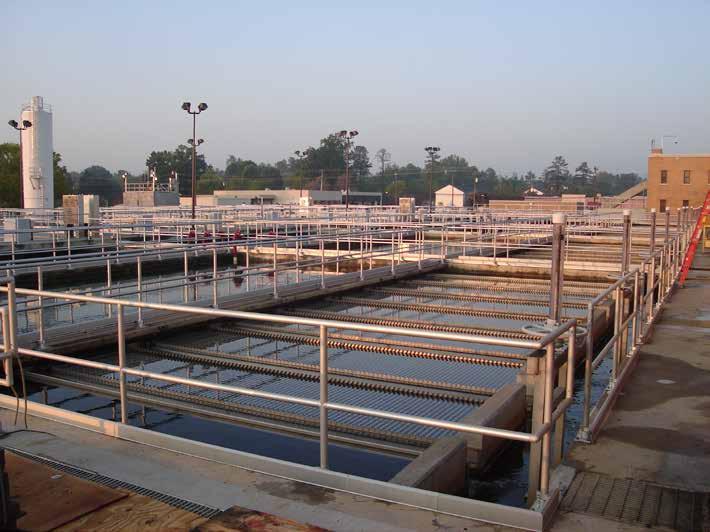
ALWAYS ON - 24/7/365
To understand the possible health effects described for many regulated contaminants, a person would have to drink two liters of water every day at the maximum contaminant level (MCL) for a lifetime to have a one-in-a-million chance of having the described health effect.
As required by law, Rock Hill monitors around the clock for contaminants in the drinking water that it treats and supplies to customers. In 2019, Rock Hill performed more than 4,000 routine water quality tests at 164 local sites. These tests measure for bacteria, chlorine residual, pH and temperature. Sites include schools, residences, commercial businesses and industries in the Rock Hill water service territory. Along with the routine tests, the City performed more than 4,000 special monitoring tests for disinfection by-products control at sixteen additional sites, lead and copper at thirty designated homes, and corrosion control at ten approved sites throughout the city. Additionally, with increased concerns about water quality within US public schools, the City expanded their corrosion control sample protocol to include testing at Rock Hill schools. This ensures our schools have protection on pipe walls to prevent possible metal leaching in the water.
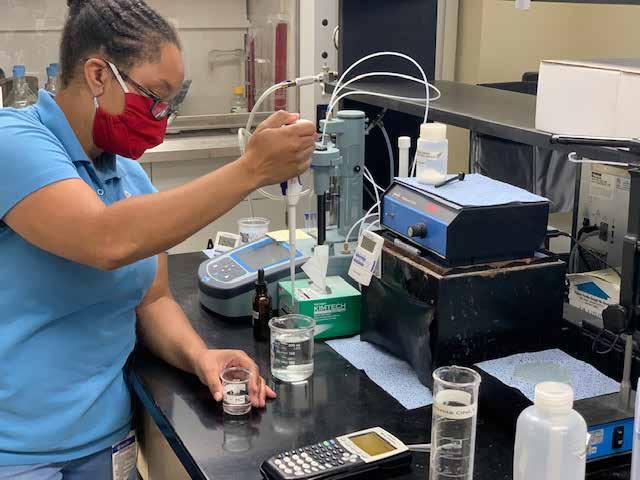
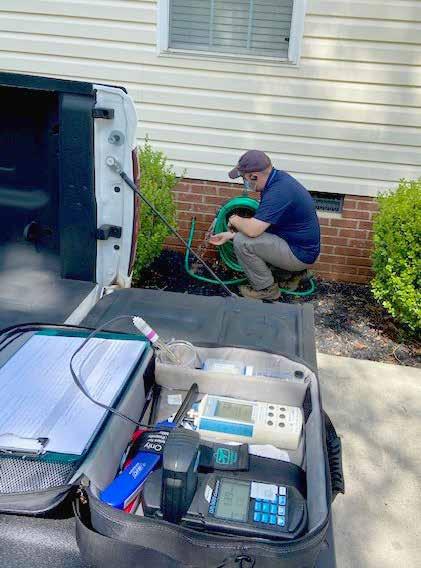
Every regulated contaminant detected in the water, even in the most minute traces, is listed in the table, which contains the name of each substance; the highest level allowed by regulation; the ideal goals for public health; the amount detected; and the likely sources of contamination. In 2019 there were more than 100 contaminants that were tested for and not detected. For a list of non-detects, call 803-329-5502.
EXCEEDING REGULATORY REQUIREMENTS
The Rock Hill Water Treatment Plant has earned the South Carolina Area-Wide Optimization Award for the 15th consecutive year! This award is given to filtration plants that exceed water regulations for particle removal and disinfection.
Please note: The City of Rock Hill’s monitoring cycle under the Lead and Copper Rule is every 3 years. The next sampling event is scheduled to start July 2020.
*See Glossary of Terms on next page
(Table continued on next page)
DRINKING WATER DATA & REPORTS
Through the Safe Drinking Water Act (SDWA), the Environmental Protection Agency (EPA) requires public water systems meet national drinking water standards to ensure that the health of water consumers is carefully protected.
All public water systems must publish an annual Consumer Confidence Report that tells how the drinking water standards are achieved. The EPA allows this report to be posted on the City’s website for customer viewing or printing. If you would like this report mailed to you, please call Customer Service at 803-325-2500 to request a paper copy.
ppm = ONE DROP in 13.6 gallons
ppb = ONE DROP in 13,563 gallons
ppt = ONE DROP in 13,563,368 gallons
2017 Water Quality Data
2017 Water
Substance Substance Substance MCLG Total Coliform MCL Highest Number of Positive Fecal Coliform or E. Coli MCL Total Number of Positive E. Coli or Fecal Coliform Samples Violation Violation Level Detected TT REGULATED CONTAMINANTS 2019
Table
Quality Data Table
Highest Level Detected Range of Levels Detected Violation Likely Source of Contamination Likely Source of Contamination Likely Source of Contamination Turbidity Coliform Bacteria Year MCLG MCL Units Substance 90th Percentile Number of Sites Over AL Violation Typical Source Year ALG AL Units Nitrate (measured as Nitrogen) MICROBIOLOGICAL SUBSTANCES 0 0 0 0 5% of monthly samples are positive No No No No Naturally present in the environment 1 NTU 0.05 NTU 100% 0.3 NTU Highest Single Measurement Lowest Monthly Percentile Soil runoff Soil runoff INORGANIC SUBSTANCES 2019 10 10 ppm 0.43 0.430.43 Runoff from fertilizer use; Leaching from Septic tanks, sewage; Erosion of natural deposits Copper No 2017 1.3 1.3 ppm 0.05 0 Erosion of natural deposits; Leaching from wood preservatives; Corrosion of household plumbing systems. Lead No 2017 0 15 ppb 0.002 0 Corrosion of household plumbing systems; Erosion of natural deposits. Fluoride No 2019 4 4.0 ppm 0.67 0.670.67 Erosion of natural deposits; Water additive which promotes strong teeth; Discharge from fertilizer and aluminum factories 2019 Water Quality Data Table
2019 Water Quality Data Table (continued)
DISINFECTANTS AND DISINFECTANTS BY-PRODUCTS
Not all sample results may have been used in calculating the Highest Level of Detected because some results may be part of an evaluation to determine where compliance sampling should occur in the future.*
RADIOACTIVE SUBSTANCES
Glossar y of Terms
in Water Quality Data Table
Definitions - The water quality tables contain scientific terms and measures, some of which may be explanation.
Action Level (AL)
The concentration which, if exceeded, triggers treatment or other requirements which a water system must follow.
Action Level Goal (ALG)
The level of a contaminant in drinking water below which there is no known or expected risk to health. AGLs allow for a margin of safety.
LRAA - Locational Running Annual Average
Maximum Contaminant Level (MCL)
The highest level of a contaminant that is allowed in drinking water. MCLs are set as close to the MCLGs as feasible using the best available treatment technology.
Maximum Contaminant Level Goal (MCLG)
The level of a contaminant in drinking water below which there is no known or expected risk to health. MCLGs allow for a margin of safety.
Minimum Reporting Levels (MRL)
The value and unit of measure at or above which the
concentration of the contaminant must be measured using the approved analytical methods.
NA - Not applicable
ND - Not detected
NR - Monitoring not required, but recommended.
Nephelometric Turbidity Units (NTU)
Turbidity is a measure of the cloudiness of the water. We monitor it because it is a good indicator of the effectiveness of our filtration system.
Parts Per Million (ppm)
Parts per million, or milligrams per liter (mg/L).
Parts Per Billion (ppb)
Parts per billion, or micrograms per liter (µg/L).
pCi/L
Picocuries per liter (a measure of radioactivity)
Treatment Technique (TT)
A required process intended to reduce the level of a contaminant in drinking water.
Referenced
Substance Range of Levels Detected Violation Likely Source of Contamination Year MCLG MCL Units Highest LRAA Detected Substance Range of Levels Detected Highest Level Detected Violation Likely Source of Contamination Collection Date MCLG MCL Units Total Organic Carbon No 2019 TT TT ppm 1.001.26 Naturally present in the environment Chlorine (as CL2) No 2019 4 4 ppm 1.201.50 Water additive used to control microbes Chlorine Dioxide (as CLO2) No 2019 0.8 0.8 ppm ND0.144 Water additive used to control microbes No 0.1440.144 By-Product of drinking water disinfection TTHMs (Total Trihalomethanes)* No 2019 No goal for the total 80 43 ppb 18.079.9 By-Product of drinking water disinfection Haloacetic Acids (HAA5)* No 2019 No goal for the total 60 19 ppb 12.027.4 By-Product of drinking water chlorination Sodium (optional) No 2019 Hardness (optional) 2019 not regulated not regulated not regulated not regulated 4.8 ppm 4.84.8 Erosion of natural deposits; Leaching No 32 ppm 1832 Erosion of natural deposits; Leaching
Substance Range of Levels Detected Violation Likely Source of Contamination Year MCLG MCL Units Level Detected 2018 0 50 ** pCi/L 3.3 No 03.3 Decay of natural and man-made deposits Gross Alpha
Chlorite 2019 0.8 1.0 ppm
** The MCL for beta particles is 4mrem/year. EPA considers 50 pCi/L to te the level of concern for beta particles.
FACTORS THAT MAY AFFECT WATER QUALITY IN YOUR HOME
THE CITY NETWORK OF PIPING
Every water system is made up of a network of pipes that delivers water from the treatment plant to your home. This piping is made up of different types of material such as ductile iron, PVC and in older systems, clay pipes. As piping ages, material will began to dissolve into the water causing taste and possible odor problems. As the water enters your home it is under the influence of your piping, faucet fixtures, the air in your home and even your hot water heater.
DIAGNOSING THE PROBLEM MILKY WATER?
Cloudy or milky water is usually an indication of air trapped inside your pipes. To rule out this problem, collect a glass of water and allow it to sit for a few minutes. If the water clears, you have air in your lines. To get rid of the air, bleed your water lines by flushing the water out from the faucet. If this does not clear up your air problem, call the City at 803-329-5500 to see if any maintenance has occurred on the main feeding your home. The next step is to call a plumber to check your water lines on your side of the meter.
If the cloudy water is not air in your lines and you see sediment that settles in your glass, you may have some calcium carbonate build up in your lines. Calcium carbonate is a harmless mineral found naturally in water. Sources of calcium build up may be in your faucet screens or in your water heater.
DISCOLORED WATER? DON’T PANIC
Naturally occurring minerals found in water such as iron and manganese can settle in your pipes causing a red or black color. Black particles may also originate from deteriorating rubber seals found around faucet strainers or inside your toilet bowl. If possible clean around these seals and flush your lines. If flushing does not clear up the discoloration, call the City at 803-329-5500 to have the mains feeding your home flushed.
BLUE STAINS can be caused by copper water pipes. You may see the appearance of blue staining in the sink or toilet bowls. Call a plumber to inspect your water lines for deterioration.
BLACK or PINK STAINING is caused by mold and mildew spores in the air. These spores land in these moist environments and form colonies that look pink or black. These organisms are not in the water, but in the air (they are not harmful). The remedy for this is to try to minimize these spores in the air. You may try allergy free filters, keeping lids down, sealing toilet tanks and fixing leaky faucets.
TASTE AND ODOR
As water travels through the network of piping in the distribution system, it may pick up harmless organic matter causing it to have taste and or odor. This is usually noticeable at the end of the water pipe line where water becomes stagnant. Some customers notice a cat urine smell when using their water. All homes have volatile organic compounds (VOCs) in the ambient air produced by scented products such as soaps, candles, air fresheners, incense, paint, carpet, furnishings, fresh flowers and many other common household items. Chlorine dioxide gas is used as a disinfectant at the water treatment plant. Chlorine dioxide combined with VOCs has been described as smelling like fuel, oil, kerosene, chemicals or cat urine. The odor will continue until the levels of VOCs decreases. The remedy is to increase ventilation by opening windows and turning on fans.
Factors that may affect
SEASONAL TURNOVER IN THE LAKE
The City of Rock Hill’s drinking water source is Lake Wylie. Lakes are sensitive to seasonal temperature changes, which causes a turnover of the water or a thermal stratification of the lake water layers. The process of stratification occurs when the atmospheric temperatures rise or fall; these temperature fluctuations cause the layers of the lake to stir, flipping the layers. This flipping of water layers stirs up the sediment in the water and may lead to taste and odor issues. Typically most customer complaints occur in late spring and at the beginning of winter with the atmospheric temperature changes.
If you have water issues that persist or if you have concerns about your water quality, please call us at 803-329-5500.
HOW DOES LEAD GET INTO DRINKING WATER?
Every water system has unique chemical and physical characteristics based on the source of the water used, the treatment processes used to create potable (drinking) water, and the piping network that takes the water from the source to the treatment plant and eventually to the individual taps. In order for lead to be present in the water at the tap, it must come from either: (1) the source water itself; (2) lead-containing materials in the distribution system or household plumbing; or (3) conditions in the treated water that would allow lead from pipes to become soluble in, or leach into, the water.
• SOURCE WATER
The City of Rock Hill draws its source water from Lake Wylie and the Catawba River. Although lead does not naturally occur in surface waters, testing for lead is required by the US EPA. Test results from samples taken at the City’s intake facility show the lead level in the source water to be only 0.0025 mg/L, well below the US EPA’s 0.015 mg/L level of concern.
• DISTRIBUTION SYSTEM AND HOUSEHOLD PIPING
Current rules and regulations do not allow for lead to be used in the manufacture of piping and plumbing materials. Although there is no known lead-containing pipe in the City of Rock Hill’s water distribution system, there may be minor components in the system that do contain lead, such as older pipe joints, certain fittings, and lead solders. Older homes and other structures connected to the system may also be plumbed with pipes, fittings, and/or fixtures that contain lead or have lead-containing soldered joints.
What does the City do to inhibit lead in drinking water?
Since there may be opportunity for lead to get in the water from older household plumbing and pipe connections, the City of Rock Hill takes proactive measures to reduce any risk.
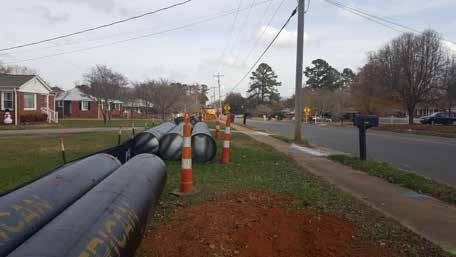
• BUFFERING
The City of Rock Hill uses both physical and chemical treatment processes to produce safe drinking water. In 1984 the City began using a corrosion inhibitor in the treatment process to prevent iron from leaching into the drinking water. The corrosion inhibitor also works to prevent other metals, such as lead and copper, from leaching into the drinking water. It does this by creating a thin film on the pipe walls to buffer, or shield, the drinking water from metals that may exist in the piping
materials. Routine water quality tests confirm that the buffering system is effective.
• CHEMICAL REACTIONS
The water crisis in Flint, Michigan, has been attributed to changing to a more acidic and corrosive water source. The more corrosive water stripped the buffering film from the inside of the pipes, allowing increased amounts of lead and metals to leach into the water. There have been no such changes to the City of Rock Hill’s source water. The treatment processes used by Rock Hill produce finished water that is non-acidic in order to maintain the protective buffering film.
• PIPE REPLACEMENT
Even though the City’s water system has been in operation for over 100 years, the average age of the piping material is only 34 years. The City invests over $1.5 million a year to replace aging and/or undersized water pipes. City employees are trained to recognize and replace service lines from the water main to the meter when necessary due to age, materials, or condition. Employees then communicate this information to the homeowner to encourage them to contact a plumber to replace the private service line between the meter and the house, and to evaluate the piping and fixtures in the house.
• 2020 SAMPLING TO BEGIN JULY - SEPTEMBER
In 1991 the US EPA implemented its Lead and Copper Rule to optimize corrosion control in drinking water systems. The City has never been in violation of this rule. In addition to periodic sampling and testing required by the Lead and Copper Rule, water quality parameters are analyzed every day at the treatment plant and annually throughout the distribution system to ensure the City remains in compliance with the rule and continues to deliver safe, quality drinking water to its customers.
EPA SAFE DRINKING WATER HOTLINE
If present, elevated levels of lead can cause serious health problems, especially for pregnant women and young children. Lead in drinking water results primarily from materials and components associated with service
way to minimize the potential for lead exposure is by flushing your tap for 30 seconds to 2 minutes before using water for drinking or cooking.
DIRECTORY
The City’s water system is governed by Rock Hill City Council and operated by the Utilities Department under the supervision of City Management.
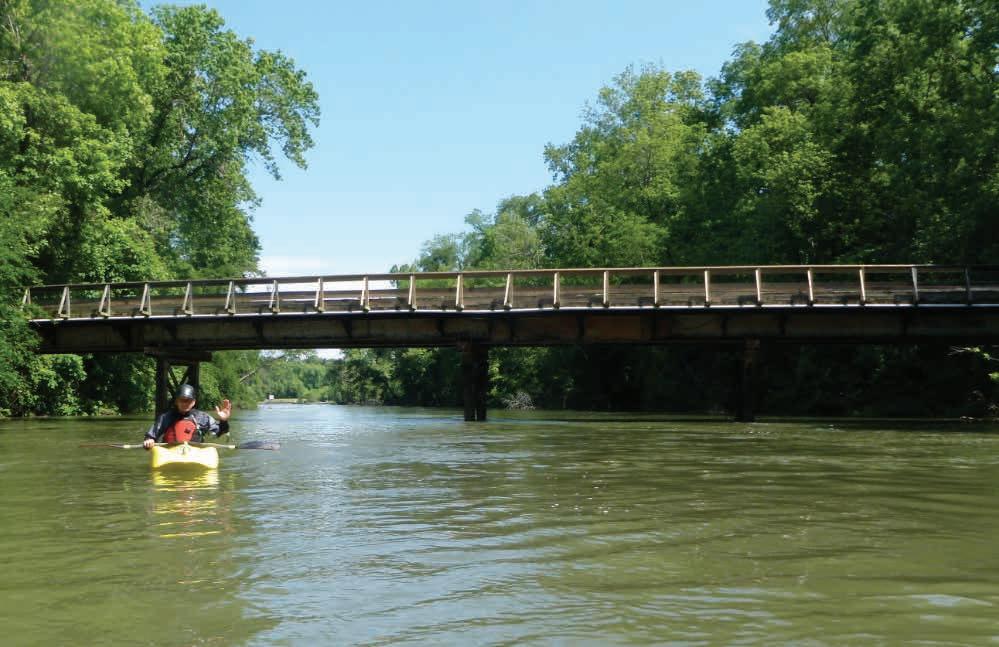
John Gettys, Mayor
Derrick Lindsay, Councilmember Ward 1
Kathy Pender, Councilmember Ward 2
Kevin Sutton, Councilmember Ward 3
John A. Black III, Councilmember Ward 4
Nikita Jackson, Councilmember Ward 5
James C. Reno Jr, Councilmember Ward 6
David B. Vehaun, City Manager
James G. Bagley Jr, PE, Deputy City Manager
Steven Gibson, Deputy City Manager
Mark Kettlewell, PE, Director of Water & Sewer Utilities
Susan Featherstone, Water Treatment Plant Superintendent
Rock Hill City Council meets on the second and fourth Mondays of each month at 6 PM. Council meetings are broadcast live and re-aired on Rock Hill’s government access channel, RHTV channel 115 for Comporium Cable customers or channel 19 (basic analog service).
Website: www.cityofrockhill.com
Customer Service, Utility Bill Questions: 803-325-2500
24-Hour Automated Service: 803-329-5500
Rock Hill Water Treatment Plant: 803-329-5502
Utilities Department: 803-329-5500
City Council/Meeting Information: 803-329-7012
TDD for Hearing Impaired: 803-329-8787
EPA Safe Drinking Water Hotline: 1-800-426-4791
South Carolina 811 - “Call Before You Dig”: Dial 811 or call toll-free 1-888-721-7877
Spanish Line: 803-325-2537
*EN ESPANOL: Este informe contiene informacion impor tante acerca de su agua potable Por favor, haga que alguien lo traduzca para usted, o hable con alguien lo entienda. Gracias
f







 New Clarifier
New Clarifier










